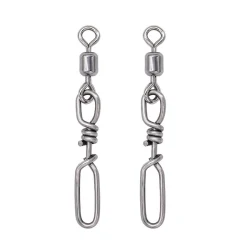Here are key components and aspects of fishing swivels
2023-12-28
Fishing swivels are small, rotating devices that are used in fishing tackle to prevent the fishing line from twisting. They are particularly useful in situations where the fishing line is prone to spin, such as when using certain types of lures or bait rigs. Swivels come in various sizes, styles, and materials to suit different fishing applications. Here are key components and aspects of fishing swivels:
1. Types of Fishing Swivels:
- Barrel Swivels: These are the most common type and consist of two rings (barrels) connected by a rotating axis. They are versatile and widely used in various fishing situations.
- Ball Bearing Swivels: Equipped with ball bearings for smoother rotation, these swivels are suitable for heavy-duty applications and situations where reduced friction is crucial.
- Three-Way Swivels: These swivels have three connection points, allowing for the attachment of multiple lines or components.
- Crosby Snap Swivels: Featuring a snap on one end, these swivels make it easy to change lures or rigs quickly without retying knots.
- Coastlock Snap Swivels: Similar to Crosby snap swivels, these have a more secure locking mechanism for attaching lures.
- Crane Swivels: Designed with a crane-like shape, these swivels are known for their strength and durability. They are often used in saltwater fishing.
2. Sizes:
- Fishing swivels come in various sizes, denoted by a numbering system. The size is generally determined by the breaking strength or weight it can handle. Common sizes include #1, #2, #3, etc.
3. Materials:
- Stainless Steel: Resistant to corrosion, stainless steel swivels are suitable for both freshwater and saltwater fishing.
- Brass: Provides good strength but may tarnish over time. Brass swivels are often used in freshwater applications.
- Nickel: Some swivels are coated with nickel for added corrosion resistance.
- High-Strength Alloys: Certain swivels are made from high-strength alloys to provide strength without adding excessive weight.
4. Pound Test Rating:
- Swivels are often labeled with a pound test rating, indicating the maximum amount of weight or force they can handle before breaking.
5. Snap vs. No Snap:
- Some swivels come with an attached snap, allowing for quick and easy attachment of lures or other terminal tackle. Others have no snap and require the use of additional connectors.
6. Rotational Freedom:
- Effective fishing swivels allow for free rotation, preventing the fishing line from becoming twisted during retrieval.
7. Application:
- Different types of swivels are suitable for various fishing applications, including trolling, casting, and bottom fishing. The choice depends on the specific fishing technique and conditions.
Fishing swivels are an essential component of terminal tackle, helping prevent line twist and improving the overall efficiency of fishing rigs. Anglers often use swivels in conjunction with leaders, lures, and other terminal tackle to enhance their fishing experience.



